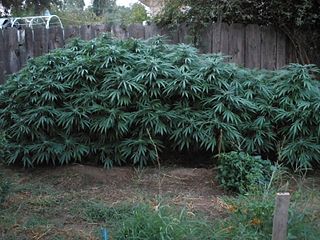Related Research Articles

Hashish, also known as hash, "dry herb, hay" is a drug made by compressing and processing parts of the cannabis plant, typically focusing on flowering buds containing the most trichomes. It is consumed by smoking, typically in a pipe, bong, vaporizer or joint, or via oral ingestion. Hash has a long history of usage in countries such as Morocco, Egypt, Afghanistan, Pakistan, India, Nepal, Iran, and Lebanon. Hash consumption is also popular in Europe. In the United States, dried flowers or concentrates are more popular, though hash has seen a rise in popularity following changes in law. Like many recreational drugs, multiple synonyms and alternative names for hash exist, and vary greatly depending on the country and native language.

Tetrahydrocannabinol (THC) is the principal psychoactive constituent of cannabis and one of at least 113 total cannabinoids identified on the plant. Although the chemical formula for THC (C21H30O2) describes multiple isomers, the term THC usually refers to the Delta-9-THC isomer with chemical name (−)-trans-Δ9-tetrahydrocannabinol. THC is a terpenoid found in cannabis and, like many pharmacologically active phytochemicals, it is assumed to be involved in the plant's evolutionary adaptation against insect predation, ultraviolet light, and environmental stress. THC was first discovered and isolated by Israeli chemist Raphael Mechoulam in Israel in 1964. It was found that, when smoked, THC is absorbed into the bloodstream and travels to the brain, attaching itself to endocannabinoid receptors located in the cerebral cortex, cerebellum, and basal ganglia. These are the parts of the brain responsible for thinking, memory, pleasure, coordination and movement.

A cannabis edible, also known as a cannabis-infused food or simply an edible, is a food item that contains decarboxylated cannabinoids from cannabis extract as an active ingredient. Although edible may refer to either a food or a drink, a cannabis-infused drink may be referred to more specifically as a liquid edible or drinkable. Edibles are a way to consume cannabis. Unlike smoking, in which cannabinoids are inhaled into the lungs and pass rapidly into the bloodstream, peaking in about ten minutes and wearing off in a couple of hours, cannabis edibles may take hours to digest, and their effects may peak two to three hours after consumption and persist for around six hours. The food or drink used may affect both the timing and potency of the dose ingested.

The effects of cannabis are caused by chemical compounds in the cannabis plant, including 113 different cannabinoids such as tetrahydrocannabinol (THC) and 120 terpenes, which allow its drug to have various psychological and physiological effects on the human body. Different plants of the genus Cannabis contain different and often unpredictable concentrations of THC and other cannabinoids and hundreds of other molecules that have a pharmacological effect, so that the final net effect cannot reliably be foreseen.

Medical cannabis, or medical marijuana (MMJ), is cannabis and cannabinoids that are prescribed by physicians for their patients. The use of cannabis as medicine has not been rigorously tested due to production and governmental restrictions, resulting in limited clinical research to define the safety and efficacy of using cannabis to treat diseases.

Cannabis sativa is an annual herbaceous flowering plant indigenous to Eastern Asia, but now of cosmopolitan distribution due to widespread cultivation. It has been cultivated throughout recorded history, used as a source of industrial fiber, seed oil, food, recreation, religious and spiritual moods and medicine. Each part of the plant is harvested differently, depending on the purpose of its use. The species was first classified by Carl Linnaeus in 1753. The word sativa means "things that are cultivated."

Cannabinol (CBN) is a mildly psychoactive cannabinoid that acts as a low affinity partial agonist at both CB1 and CB2 receptors. This activity at CB1 and CB2 receptors constitutes interaction of CBN with the endocannabinoid system (ECS).

Cannabidiol (CBD) is a phytocannabinoid discovered in 1940. It is one of 113 identified cannabinoids in cannabis plants, along with tetrahydrocannabinol (THC), and accounts for up to 40% of the plant's extract. As of 2019, clinical research on CBD included studies related to anxiety, cognition, movement disorders, and pain, but there is insufficient high-quality evidence that cannabidiol is effective for these conditions. Nevertheless, CBD is a herbal dietary supplement promoted with unproven claims of particular therapeutic effects. The global market size for CBD was predicted to exceed US$47 billion by 2028.

Cannabis, also known as marijuana among other names, is a psychoactive drug from the cannabis plant. Native to Central or South Asia, the cannabis plant has been used as a drug for both recreational and entheogenic purposes and in various traditional medicines for centuries. Tetrahydrocannabinol (THC) is the main psychoactive component of cannabis, which is one of the 483 known compounds in the plant, including at least 65 other cannabinoids, such as cannabidiol (CBD). Cannabis can be used by smoking, vaporizing, within food, or as an extract.

Cannabis indica is an annual plant species in the family Cannabaceae which produces large amounts of tetrahydrocannabinol (THC) and is cultivated for purposes including hashish in India. The high concentrations of THC provide euphoric effects making it popular for use both as a recreational drug, alternative medicine, and a clinical research drug.

Cannabis smoking is the inhalation of smoke or vapor released by heating the flowers, leaves, or extracts of cannabis and releasing the main psychoactive chemical, Δ9-tetrahydrocannabinol (THC), which is absorbed into the bloodstream via the lungs. Archaeological evidence indicates cannabis with high levels of THC was being smoked at least 2,500 years ago.

Cannabis consumption refers to the variety of ways cannabis is consumed, among which inhalation and ingestion are most common. All consumption methods involve heating the plant's THCA to decarboxylate it into THC, either at the time of consumption or during preparation. Salves and absorption through the skin (transdermal) are increasingly common in medical uses, both of CBD, THC, and other cannabinoids. Each method leads to subtly different psychoactive effects due to the THC and other chemicals being activated, and then consumed through different administration routes. It is generally considered that smoking, which includes combustion toxins, comes on quickly but lasts for a short period of time, while eating delays the onset of effect but the duration of effect is typically longer. In a 2007 ScienceDaily report of research conducted at the University of California–San Francisco, researchers reported that vaporizer users experience the same biological effect, but without the toxins associated with smoking. Δ9-THC is the primary component when inhaled, but when eaten the liver converts this to the more psychoactive 11-hydroxy-THC form.

Cannabis strains are either pure or hybrid varieties of the plant genus Cannabis, which encompasses the species C. sativa, C. indica, and C. ruderalis.

The International Nonproprietary Name dronabinol, also known under the trade names Marinol, Syndros, Reduvo and Adversa, is a generic name for the molecule of delta-9-tetrahydrocannabinol in the pharmaceutical context. It has indications as an appetite stimulant, antiemetic, and sleep apnea reliever and is approved by the FDA as safe and effective for HIV/AIDS-induced anorexia and chemotherapy-induced nausea and vomiting only.

The long-term effects of cannabis have been the subject of ongoing debate. Because cannabis is illegal in most countries, clinical research presents a challenge and there is limited evidence from which to draw conclusions. In 2017, the U.S. National Academies of Sciences, Engineering, and Medicine issued a report summarizing much of the published literature on health effects of cannabis, into categories regarded as conclusive, substantial, moderate, limited and of no or insufficient evidence to support an association with a particular outcome.

Cannabis use disorder (CUD), also known as cannabis addiction or marijuana addiction, is defined in the fifth revision of the Diagnostic and Statistical Manual of Mental Disorders (DSM-5) and ICD-10 as the continued use of cannabis despite clinically significant impairment.

Tetrahydrocannabinolic acid is a precursor of tetrahydrocannabinol (THC), an active component of cannabis.
The entourage effect is a hypothesis that cannabis compounds other than tetrahydrocannabinol (THC) act synergistically with it to modulate the overall psychoactive effects of the plant.

Cannabis has served as an entheogen—a chemical substance used in religious or spiritual contexts—in the Indian subcontinent since the Vedic period dating back to approximately 1500 BCE, but perhaps as far back as 2000 BCE. It was introduced to the New World by the Spaniards in 1530-1545. Cannabis has been used by shamanic and pagan cultures to ponder deeply religious and philosophical subjects related to their tribe or society, to achieve a form of enlightenment, to unravel unknown facts and realms of the human mind and subconscious, and also as an aphrodisiac during rituals or orgies. There are several references in Greek mythology to a powerful drug that eliminated anguish and sorrow. Herodotus wrote about early ceremonial practices by the Scythians, thought to have occurred from the 5th to 2nd century BCE. Itinerant Hindu saints have used it in the Indian subcontinent for centuries. Mexican-Indian communities occasionally use cannabis in religious ceremonies by leaving bundles of it on church altars to be consumed by the attendees.

Delta-8-tetrahydrocannabinol is a psychoactive cannabinoid found in the Cannabis plant. It is an isomer of delta-9-tetrahydrocannabinol, the compound commonly known as THC. ∆8-THC is under preliminary research for its biological properties.
References
- 1 2 Atakan Z, Morrison P, Bossong MG, Martin-Santos R, Crippa JA (January 2012). "The effect of cannabis on perception of time: a critical review". Current Pharmaceutical Design. 18 (32): 4915–4922. doi:10.2174/138161212802884852. ISSN 1873-4286. PMID 22716134.
- ↑ Stolick M (2008). Otherwise Law-Abiding Citizens: A Scientific and Moral Assessment of Cannabis Use. Lanham, MD: Lexington Books. ISBN 9780739131619. Archived from the original on 2023-04-20. Retrieved 2023-04-20.
- ↑ Green B, Kavanagh D, Young R (December 2003). "Being stoned: a review of self-reported cannabis effects". Drug and Alcohol Review. 22 (4): 453–460. doi:10.1080/09595230310001613976. ISSN 0959-5236. PMID 14660135.
- ↑ Iversen L (June 2003). "Cannabis and the brain". Brain. 126 (Pt 6): 1252–1270. doi: 10.1093/brain/awg143 . ISSN 0006-8950. PMID 12764049.
- ↑ Stella N (August 2013). "Chronic THC intake modifies fundamental cerebellar functions". The Journal of Clinical Investigation. 123 (8): 3208–3210. doi:10.1172/JCI70226. ISSN 0021-9738. PMC 3967658 . PMID 23863631.
- ↑ Earleywine M (2002). Understanding Marijuana: A New Look at the Scientific Evidence . Oxford University Press. ISBN 9780199881437.
- ↑ Jones HC, Lovinger PW (1985). The Marijuana Question: And Science's Search for an Answer. New York: Dodd, Mead. ISBN 0396083994.
- ↑ Jones, Helen Cc; Paul W. Lovinger (1985) The Marijuana Question and Science's Search for an Answer. Dodd Mead. ISBN 0396083994.
- ↑ Ginsberg A (November 1966). "The Great Marijuana Hoax: First Manifesto to End the Bringdown". Atlantic Monthly. pp. 104, 107–112. Archived from the original on 26 June 2017. Retrieved 27 April 2017. (part two of article Archived 2021-03-01 at the Wayback Machine )
- ↑ Groopman, Jerome. (February 20, 2014). Marijuana: The High and the Low Archived 2014-08-14 at the Wayback Machine . The New York Review of Books. Retrieved August 9, 2014.
- ↑ Chait LD, Pierri J (1992). "Effects of smoked marijuana on human performance: a critical review". Marijuana/Cannabinoids: Neurobiology and Neurophysiology. 387: 423.
- ↑ "Music: The Weed, Teenage". www.druglibrary.org. 19 July 1943. Archived from the original on 29 April 2017. Retrieved 27 April 2017.
- ↑ Fachner, Jörg (July 2001). The Space between the Notes—Research on Cannabis and Music Perception Archived 2014-08-25 at the Wayback Machine . 11th IASPM Conference, Day Two (Subjectivities and Identities). pp. 308-319. ISBN 951-98789-1-2
- ↑ Aldridge D, Fachner J (2006). Music and Altered States: Consciousness, Transcendence, Therapy and Addiction. Philadelphia: Jessica Kingsley Publishers. ISBN 9781843103738. Archived from the original on 2023-04-20. Retrieved 2017-04-27.
- ↑ Aldridge D (2005). Case Study Designs in Music Therapy. Philadelphia: Jessica Kingsley Publishers. ISBN 9781843101406. Archived from the original on 2023-04-20. Retrieved 2017-04-27.
- ↑ Booth M (2011). Cannabis: A History. Random House. ISBN 9781409084891. Archived from the original on 2023-04-20. Retrieved 2017-04-27.